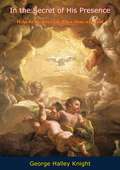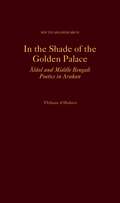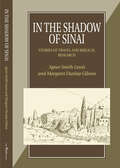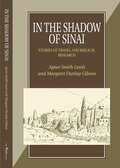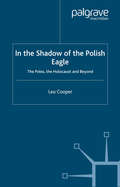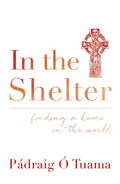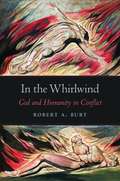- Table View
- List View
In the Path of God: Islam and Political Power
by Daniel PipesAmericans' awareness of Islam and Muslims rose to seemingly unprecedented heights in the immediate aftermath of September 11, 2001, but this is not the first time they have dominated American public life. Once before, during the period of the Iranian revolution and hostage crisis of 1979 to 1981, Americans found themselves targeted as a consequence of a militant interpretation of Islam. Daniel Pipes wrote In the Path of God in response to those events, and the heightened interest in Islam they generated. His objective was to present an overview of the connection between in Islam and political power through history in a way that would explain the origins of hostility to Americans and the West. Its relevance to our understanding of contemporary events is self evident. Muslim antagonism toward the West is deeply rooted in historical experience. In premodern times, the Islamic world enjoyed great success, being on the whole more powerful and wealthier than their neighbors. About two hundred years ago, a crisis developed, as Muslims became aware of the West's overwhelming force and economic might. While they might have found these elements attractive, Muslims found European culture largely alien and distasteful. The resulting resistance to Westernization by Muslims has deep roots, has been more persistent than that of other peoples, and goes far to explain the deep Muslim reluctance to accept modern ways. In short, Muslims saw what the West had and wanted it too, but they rejected the methods necessary to achieve this. This, the Muslim trauma, has only worsened over the years.
In the Presence of God: Find Answers to the Challenges of Life
by Creflo A. DollarThrough insightful teaching and an intense focus on God's Word, Dr. Creflo A. Dollar will help readers discover the keys to living in God's presence where all answers are found.
In the Secret of His Presence: Helps for the Inner Life When Alone with God
by George KnightAPART from strictly devotional books, a large proportion of the practical Christian literature of the day concerns itself rather with the outer manifestations of the Christian life than with its inner experiences. The Christian as he moves among men is in view, rather than the Christian as he is alone with God.Books of this class are invaluable helps to Christian living, and can hardly be multiplied too much.But, along with these, there may be some room for books of another class, books dealing specially with the inner soul-experiences which vitalise the life that is seen.This volume is meant to be of such a kind: to set forth in some degree the sacred privilege of secret fellowship with God, and to urge the need of making that intercourse with Him more frequent and more prolonged.If it helps any reader of it to realise more fully the joy to be found in the secret place of meditation and prayer, its purpose will be fulfilled.
In the Self's Place: The Approach of Saint Augustine (Cultural Memory in the Present)
by Jean-Luc MarionIn the Self's Place is an original phenomenological reading of Augustine that considers his engagement with notions of identity in Confessions. Using the Augustinian experience of confessio, Jean-Luc Marion develops a model of selfhood that examines this experience in light of the whole of the Augustinian corpus. Towards this end, Marion engages with noteworthy modern and postmodern analyses of Augustine's most "experiential" work, including the critical commentaries of Jacques Derrida, Martin Heidegger, and Ludwig Wittgenstein. Marion ultimately concludes that Augustine has preceded postmodernity in exploring an excess of the self over and beyond itself, and in using this alterity of the self to itself, as a driving force for creative relations with God, the world, and others. This reading establishes striking connections between accounts of selfhood across the fields of contemporary philosophy, literary studies, and Augustine's early Christianity.
In the Shade of the Golden Palace: Alaol and Middle Bengali Poetics in Arakan (South Asia Research)
by Thibaut d'HubertIn the Shade of the Golden Palace explores the work of the prolific Bengali poet Alaol (fl. 1651-71), who translated five narrative poems and one versified treatise from medieval Hindi and Persian into Bengali. The book maps the genres, structures, and themes of Alaol's works, paying special attention to his discourse on poetics and his literary genealogy, which included Sanskrit, Avadhi, Maithili, Persian, and Bengali authors. D'Hubert focuses on courtly speech in Alaol's poetry, his revisiting of classical categories in a vernacular context, and the prominent role of performing arts in his conceptualization of the poetics of the written word. The foregrounding of this audacious theory of meaning in Alaol's poetry is a crucial contribution of the book, both in terms of general conceptual analysis and for its significance in the history of Bengali poetry. This book shows how multilingual literacy fostered a variety of literary experiments in the remote kingdom of Arakan, which lay between present-day southeastern Bangladesh and Myanmar, in the mid-17th century. D'Hubert also presents a detailed analysis of Middle Bengali narrative poems, as well as translations of Old Maithili, Brajabuli, and Middle Bengali lyric poems that illustrate the major poetic styles in the regional courts of eastern South Asia. In the Shade of the Golden Palace therefore fulfills three functions: it is a unique guide for readers of Middle Bengali poetry, a detailed study of the cultural history of the frontier region of Arakan, and an original contribution to the poetics of South Asian literatures.
In the Shade of the Golden Palace: Alaol and Middle Bengali Poetics in Arakan (South Asia Research)
by Thibaut d'HubertIn the Shade of the Golden Palace explores the work of the prolific Bengali poet Alaol (fl. 1651-71), who translated five narrative poems and one versified treatise from medieval Hindi and Persian into Bengali. The book maps the genres, structures, and themes of Alaol's works, paying special attention to his discourse on poetics and his literary genealogy, which included Sanskrit, Avadhi, Maithili, Persian, and Bengali authors. D'Hubert focuses on courtly speech in Alaol's poetry, his revisiting of classical categories in a vernacular context, and the prominent role of performing arts in his conceptualization of the poetics of the written word. The foregrounding of this audacious theory of meaning in Alaol's poetry is a crucial contribution of the book, both in terms of general conceptual analysis and for its significance in the history of Bengali poetry. This book shows how multilingual literacy fostered a variety of literary experiments in the remote kingdom of Arakan, which lay between present-day southeastern Bangladesh and Myanmar, in the mid-17th century. D'Hubert also presents a detailed analysis of Middle Bengali narrative poems, as well as translations of Old Maithili, Brajabuli, and Middle Bengali lyric poems that illustrate the major poetic styles in the regional courts of eastern South Asia. In the Shade of the Golden Palace therefore fulfills three functions: it is a unique guide for readers of Middle Bengali poetry, a detailed study of the cultural history of the frontier region of Arakan, and an original contribution to the poetics of South Asian literatures.
In the Shadow of Sinai: Stories of Travel and Biblical Research
by Agnes Smith LewisIN THE SHADOW OF SINAI: A STORY OF TRAVEL AND RESEARCH FROM 1895-1897 and HOW THE CODEX WAS FOUND: A NARRATIVE OF TWO VISITS TO SINAI: FROM MRS LEWIS'S JOURNALS, 1892-1893—published here in a new one-volume edition—were originally published in the late 1890's, to great acclaim. They are not only interesting and witty travelogues, but they are also a superb record of the discovery of the Syriac palimpsest, and a narrative of the journeys and adventures surrounding that research. The text describes a very remarkable variant of the reported spoken word of Jesus Christ (Matthew xii: 36), which will be of interest to all Christians and scholars.
In the Shadow of Sinai: Stories of Travel and Biblical Research (The\canada Blanch / Sussex Academic Stud Ser.)
by Agnes Smith LewisIN THE SHADOW OF SINAI: A STORY OF TRAVEL AND RESEARCH FROM 1895-1897 and HOW THE CODEX WAS FOUND: A NARRATIVE OF TWO VISITS TO SINAI: FROM MRS LEWIS'S JOURNALS, 1892-1893—published here in a new one-volume edition—were originally published in the late 1890's, to great acclaim. They are not only interesting and witty travelogues, but they are also a superb record of the discovery of the Syriac palimpsest, and a narrative of the journeys and adventures surrounding that research. The text describes a very remarkable variant of the reported spoken word of Jesus Christ (Matthew xii: 36), which will be of interest to all Christians and scholars.
In the Shadow of the Mahatma: Bishop Azariah and the Travails of Christianity in British India
by Susan Billington HarperThis is a biography of Vedanayagam Samuel Azariah (1874-1945), bishop of the Anglican Church in India from 1912 until his death in 1945. His life sheds new light on the challenges and opportunities faced by religious minorities throughout the world today. As a Christian leader in a non-Christian culture, he negotiated complex cultural, social, political, and economic pressure with exceptional skill and diplomacy. As the first Indian bishop of an Anglican diocese, and as modern India's most successful leader of depressed class and non-Brahmin conversion movements to Christianity, Azariah was equally at home with the untouchables of rural India and the unreachables of the British Empire. From this platform Azariah inevitably came into contact - and, ironically, also into conflict - with the dominating presence of Mahatma Gandhi.Susan Billington Harper here reconstructs major events and issues of Azariah's public life, including a previously unstudied controversy with Gandhi over the issue of conversion and relgious freedom in the 1930s. Based on hitherto untapped primary sources, including diocesan records and vernacular oral histories expressed in both stories and songs, this fascinating volume not only provides the first critical study of Bishop Azariah's life but also offers important - at times challenging - insights for those interested in modern India and the place of Christianity within it.
In the Shadow of the Mahatma: Bishop Azariah and the Travails of Christianity in British India
by Susan Billington HarperThis is a biography of Vedanayagam Samuel Azariah (1874-1945), bishop of the Anglican Church in India from 1912 until his death in 1945. His life sheds new light on the challenges and opportunities faced by religious minorities throughout the world today. As a Christian leader in a non-Christian culture, he negotiated complex cultural, social, political, and economic pressure with exceptional skill and diplomacy. As the first Indian bishop of an Anglican diocese, and as modern India's most successful leader of depressed class and non-Brahmin conversion movements to Christianity, Azariah was equally at home with the untouchables of rural India and the unreachables of the British Empire. From this platform Azariah inevitably came into contact - and, ironically, also into conflict - with the dominating presence of Mahatma Gandhi.Susan Billington Harper here reconstructs major events and issues of Azariah's public life, including a previously unstudied controversy with Gandhi over the issue of conversion and relgious freedom in the 1930s. Based on hitherto untapped primary sources, including diocesan records and vernacular oral histories expressed in both stories and songs, this fascinating volume not only provides the first critical study of Bishop Azariah's life but also offers important - at times challenging - insights for those interested in modern India and the place of Christianity within it.
In the Shadow of the Polish Eagle: The Poles, the Holocaust and Beyond
by L. CooperThe behaviour of many Poles towards the Jewish population during the Nazi occupation of Poland has always been a controversial issue. Although the Poles are supposed not to have collaborated with the invaders, there is evidence to show that in respect of the Jewish population, the behaviour of many Poles, including members of the underground, was far from exemplary. Poland is also the only European country where Jews were being murdered after the end of the war and where strong anti-Semitic tendencies are still present. This book analyses this question in an historical context and attempts to offer an explanation for the phenomenon of Polish anti-Semitism during and after the end of the war. The work is based on recently uncovered documents as well as on personal accounts of witnesses to the events during the war.
In the Shadows of the Holocaust and Communism: Czech and Slovak Jews Since 1945
by Alena HeitlingerWhen traumatic historical events and transformations coincide with one's entry into young adulthood, the personal and historical significance of life-course transitions interact and intensify. In this volume, Alena Heitlinger examines identity formation among a generation of Czech and Slovak Jews who grew up under communism, coming of age during the de-Stalinization period of 1962-1968.Heitlinger's main focus is on the differences and similarities within and between generations, and on the changing historical and political circumstances of state socialism/communism that have shaped an individual's consciousness and identity—as a Jew, assimilated Czech, Slovak, Czechoslovak and, where relevant, as an emigre or an immigrant. The book addresses a larger set of questions about the formation of Jewish identity in the midst of political upheavals, secularization, assimilation, and modernity: Who is a Jew? How is Jewish identity defined? How does Jewish identity change based on different historical contexts? How is Jewish identity transmitted from one generation to the next? What do the Czech and Slovak cases tell us about similar experiences in other former communist countries, or in established liberal democracies?Heitlinger explores the official and unofficial transmission of Holocaust remembering (and non-remembering), the role of Jewish youth groups, attitudes toward Israel and Zionism, and the impact of the collapse of communism. This volume is rich in both statistical and archival data and in its analysis of historical, institutional, and social factors. Heitlinger's wide-ranging approach shows how history, generational, and individual biography intertwine in the formation of ethnic identity and its ambiguities.
In the Shadows of the Holocaust and Communism: Czech and Slovak Jews Since 1945
by Alena HeitlingerWhen traumatic historical events and transformations coincide with one's entry into young adulthood, the personal and historical significance of life-course transitions interact and intensify. In this volume, Alena Heitlinger examines identity formation among a generation of Czech and Slovak Jews who grew up under communism, coming of age during the de-Stalinization period of 1962-1968.Heitlinger's main focus is on the differences and similarities within and between generations, and on the changing historical and political circumstances of state socialism/communism that have shaped an individual's consciousness and identity—as a Jew, assimilated Czech, Slovak, Czechoslovak and, where relevant, as an emigre or an immigrant. The book addresses a larger set of questions about the formation of Jewish identity in the midst of political upheavals, secularization, assimilation, and modernity: Who is a Jew? How is Jewish identity defined? How does Jewish identity change based on different historical contexts? How is Jewish identity transmitted from one generation to the next? What do the Czech and Slovak cases tell us about similar experiences in other former communist countries, or in established liberal democracies?Heitlinger explores the official and unofficial transmission of Holocaust remembering (and non-remembering), the role of Jewish youth groups, attitudes toward Israel and Zionism, and the impact of the collapse of communism. This volume is rich in both statistical and archival data and in its analysis of historical, institutional, and social factors. Heitlinger's wide-ranging approach shows how history, generational, and individual biography intertwine in the formation of ethnic identity and its ambiguities.
In the Shelter: Finding a Home in the World
by Padraig O TuamaIt is in the shelter of each other that the people live.Drawing on this Irish saying, poet, storyteller and theologian Pádraig Ó Tuama relates ideas of shelter and welcome to journeys of life, using poetry, story, biblical refelction and prose to open up gentle ways of living well in a troubled world. The fourth gospel tells of Jesus arriving in the room where the disciples are gathered, full of fear, on Easter Sunday. He does not chide or admonish; instead he says 'Peace be with you', which, in the Aramaic of his day, was simply a greeting. To people locked in a room of fear he said 'Hello,' welcoming them to a place of deep encounter: encounter with themselves, with their fear, with each other and with the incarnate one in their midst.Interweaving everyday stories with narrative theology, gospel reflections with mindfulness and Celtic spirituality with poetry, In the Shelter reveals the transformational power of welcome.
In the Shelter of Elyon: Essays on Ancient Palestinian Life and Literature (The Library of Hebrew Bible/Old Testament Studies)
by W. Boyd Barrick John R. SpencerThis magnificent collection of articles on OT literature, history, religion and culture comprises the following studies: A.L. Merrill and J.R. Spencer, 'The Uppsala School' of Biblical Studies. W. Boyd Barrick, G.W. Ahlström in Profile. B. Glazier-McDonald, G.W. Ahlström: A Bibliography. W. Boyd Barrick and J.R. Spencer, Parentheses in a Snowstorm: G.W. Ahlström and the Study of Ancient Palestine. P.A.H. de Boer, Psalm 81.6a: Observations on Translation and Meaning of One Hebrew Line. N.C. Habel, The Role of Elihu in the Design of the Book of Job. C.E. L'Heureux, The Redactional History of Isaiah 5.1-10.4. D. Pardee, The Semantic Parallelism of Psalm 89. J. Van Seters, Joshua 24 and the Problem of Tradition in the Old Testament. M. Haran, The Shining of Moses' Face: A Case in Biblical and Ancient Near Eastern Iconography. A.S. Kapelrud, The Prophets and the Covenant. M. Ottosson, The Prophet Elijah's Visit to Zarephath. B. Otzen, Heavenly Visions in Early Judaism: Origin and Function. A.W. Sjöberg, Eve and the Chameleon. G. Widengren, Yahweh's Gathering of the Dispersed. P.R. Ackroyd, The Biblical Interpretation of the Reigns of Ahaz and Hezekiah. S. Herrmann, King David's State. S.A. Kaufman, A Reconstruction of the Social Welfare Systems of Ancient Israel. T.W. Overholt, Thoughts on the Use of Charisma in Old Testament Studies. J.M. Sasson, The Biographic Mode in Hebrew Historiography.
In the Spirit of...Christmas and A Very Special Delivery: In the Spirit of...Christmas / A Very Special Delivery (Mills & Boon Love Inspired)
by Linda GoodnightHeartwarming stories of holiday romance by RITA Award-winning author Linda Goodnight In the Spirit of…Christmas
In the Spirit of Happiness
by Monks of New SketeThe bestselling authors of "How to Be Your Dog's Best Friend" show how their strong connections with dogs and the natural world stem from the principles of monastic life. The elements of a monk's life -- self-discipline, solitude, prayer, acts of love and forgiveness -- are pathways that anyone can follow to achieve true happiness and spiritual fulfillment.
In the Time of Oil: Piety, Memory, and Social Life in an Omani Town
by Mandana LimbertBefore the discovery of oil in the late 1960s, Oman was one of the poorest countries in the world, with only six kilometers of paved roads and one hospital. By the late 1970s, all that had changed as Oman used its new oil wealth to build a modern infrastructure. In the Time of Oil describes how people in Bahla, an oasis town in the interior of Oman, experienced this dramatic transformation following the discovery of oil, and how they now grapple with the prospect of this resource's future depletion. Focusing on shifting structures of governance and new forms of sociality as well as on the changes brought by mass schooling, piped water, and the fracturing of close ties with East Africa, Mandana Limbert shows how personal memories and local histories produce divergent notions about proper social conduct, piety, and gendered religiosity. With close attention to the subtleties of everyday life and the details of archival documents, poetry, and local histories, Limbert provides a rich historical ethnography of oil development, piety, and social life on the Arabian Peninsula.
In the Valley of the Kauravas: A Divine Kingdom in the Western Himalaya
by William S. SaxThe isolated valleys of Rawain in the Western Himalaya are ruled by local gods who control the weather, provide justice, and regularly travel through their territories to mark their borders and to ward off incursions by rival gods. These, identified with Karna and Duryodhana from the great Indian epic Mahabharata, are regarded as divine kings whom local persons serve as priests, ministers, patrons, soldiers, and servants. Each divine kings has an oracle, who is regularly summoned, enters into a trance, and speaks with the god's voice, appointing and dismissing officers, confiscating property, levying fines, and ratifying the decisions of councils of elders. The gods hear civil and sometimes criminal cases and, through their oracles, enforce their judgments through fines and penalties, or by compelling disputants to reach a compromise. In the Valley of the Kauravas seeks to describe how this system functions by closely examining the myths, legends, rituals, and folklore associated with it, and above all by providing a detailed ethnographic description of its day-to-day workings. It contextualizes this system by comparing it with 'divine kingship' throughout history, in both South and Southeast Asia, and seeks to embed this historical and ethnographic analysis in a theoretical discussion of the nature, goals, and limits of anthropological knowledge of 'multiple worlds'. The chapters of the book are organized in terms of the 'seven limbs' of the classical Indian kingdom as described by the political philosopher Kautilya: king, land and people, minister, army, treasury, ally, and enemy.
In the Valley of the Kauravas: A Divine Kingdom in the Western Himalaya
by William S. SaxThe isolated valleys of Rawain in the Western Himalaya are ruled by local gods who control the weather, provide justice, and regularly travel through their territories to mark their borders and to ward off incursions by rival gods. These, identified with Karna and Duryodhana from the great Indian epic Mahabharata, are regarded as divine kings whom local persons serve as priests, ministers, patrons, soldiers, and servants. Each divine kings has an oracle, who is regularly summoned, enters into a trance, and speaks with the god's voice, appointing and dismissing officers, confiscating property, levying fines, and ratifying the decisions of councils of elders. The gods hear civil and sometimes criminal cases and, through their oracles, enforce their judgments through fines and penalties, or by compelling disputants to reach a compromise. In the Valley of the Kauravas seeks to describe how this system functions by closely examining the myths, legends, rituals, and folklore associated with it, and above all by providing a detailed ethnographic description of its day-to-day workings. It contextualizes this system by comparing it with 'divine kingship' throughout history, in both South and Southeast Asia, and seeks to embed this historical and ethnographic analysis in a theoretical discussion of the nature, goals, and limits of anthropological knowledge of 'multiple worlds'. The chapters of the book are organized in terms of the 'seven limbs' of the classical Indian kingdom as described by the political philosopher Kautilya: king, land and people, minister, army, treasury, ally, and enemy.
In the Whirlwind: God and Humanity in Conflict
by Robert A. BurtIn this bold exploration of the political theory of the Hebrew and Christian Bibles, Burt shows that God’s authority is no less inherently problematic and in need of justification than the legitimacy of secular government. He paints a surprising picture of the ambivalent, mutually dependent relationship between God and his peoples.
In the Whirlwind: God and Humanity in Conflict
by Robert A. BurtIn this bold exploration of the political theory of the Hebrew and Christian Bibles, Burt shows that God’s authority is no less inherently problematic and in need of justification than the legitimacy of secular government. He paints a surprising picture of the ambivalent, mutually dependent relationship between God and his peoples.
In Their Own Words: Understanding Lashkar-e-Tayyaba
by C. Christine FairThis path-breaking volume reveals a little-known aspect of how Lashkar-e-Tayyaba, a jihadist terrorist group, functions in Pakistan and beyond by translating and commenting upon a range of publications produced and disseminated by Dar-ul-Andlus, the publishing wing of LeT. Only a fraction of LeT's cadres ever see battle: most of them are despatched on nation-wide "prozelytising" (dawa) missions to convert Pakistanis to their particular interpretation of Islam, in support of which LeT has developed a sophisticated propagandist literature. This canon of Islamist texts is the most popular and potent weapon in LeT's arsenal, and its scrutiny affords insights into how and who the group recruits; LeT's justification for jihad; its vision of itself in global and regional politics; the enemies LeT identifies and the allies it cultivates; and how and where it conducts its operations. Particular attention is paid to the role that LeT assigns to women by examining those writings which heap extravagant praise upon the mothers of aspirant jihadis, who bless their operations and martyrdom. It is only by understanding LeT's domestic functions as set out in these texts that one can begin to appreciate why Pakistan so fiercely supports it, despite mounting international pressure to disband the group.
In Their Own Words: Understanding Lashkar-e-Tayyaba
by C. Christine FairThis path-breaking volume reveals a little-known aspect of how Lashkar-e-Tayyaba, a jihadist terrorist group, functions in Pakistan and beyond by translating and commenting upon a range of publications produced and disseminated by Dar-ul-Andlus, the publishing wing of LeT. Only a fraction of LeT's cadres ever see battle: most of them are despatched on nation-wide "prozelytising" (dawa) missions to convert Pakistanis to their particular interpretation of Islam, in support of which LeT has developed a sophisticated propagandist literature. This canon of Islamist texts is the most popular and potent weapon in LeT's arsenal, and its scrutiny affords insights into how and who the group recruits; LeT's justification for jihad; its vision of itself in global and regional politics; the enemies LeT identifies and the allies it cultivates; and how and where it conducts its operations. Particular attention is paid to the role that LeT assigns to women by examining those writings which heap extravagant praise upon the mothers of aspirant jihadis, who bless their operations and martyrdom. It is only by understanding LeT's domestic functions as set out in these texts that one can begin to appreciate why Pakistan so fiercely supports it, despite mounting international pressure to disband the group.
In Too Deep: Undercover Memories In Too Deep Framed For Christmas (Mills And Boon Love Inspired Suspense Ser.)
by Sharon DunnA witness's life in jeopardy…And he'll blow his cover to protect her


